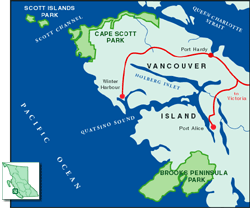Nels Bight, Hansen Lagoon, and Frederiksen Point – names. These geographic reminders are pretty much all that’s left of a dream to farm and live off the land on the northwest coast of Vancouver Island.
Back in the late 1800s, the rugged coastline near Cape Scott was even more remote and inhospitable than it feels today. However, that failed to deter a group of Danish settlers who travelled from Minnesota, Iowa, Nebraska and North Dakota to hack a settlement out of the windswept coastal forests of Cape Scott.
They wanted to build a Danish colony at Hansen Lagoon and Fisherman Bay. It might have seemed like a bright idea then, but in hindsight, it was idealistic, almost naïve. Winters were long, cold and wet, and summers cool and foggy. And it was accessible only by boat.

The plan was to live off fishing until the government followed through on a promise to build a road connecting the colony to San Josef River and Holberg 30 kilometres to the south.
The road never materialized, and with it went the settler’s plan to get beef, dairy, and other farm products to market.
The Danes hung on for several more years, surviving on fishing and trapping. By 1907, the struggling colony was all but abandoned as the men dispersed to work in logging, mining and fishing camps.
Wolvers and other wildlife barely had time to occupy the vacated buildings when another wave of settlers started arriving in 1913—this time from the Prairies, Washington State, Eastern Canada, and Europe.
The newcomers were attracted by the free land and the opportunity to move into houses recently abandoned by the Danes. Others built new homes at San Josef Bay. The population of Cape Scott soon peaked at more than 1,000.
But it’s no surprise that the newcomers surrendered to the same challenges faced by the Danes; their grit was no match for the harsh climate, remoteness and land that was unfit for agriculture.
World War I brought the draft, which caused the second wave of settlement to crash. Cape Scott was abandoned again. In a few years, Cape Scott returned to a coastal wilderness.
Today, besides a few place names on a map, only decaying buildings stand to remind us of those settler dreams that took shape for a moment in history and then died on northern Vancouver Island.









